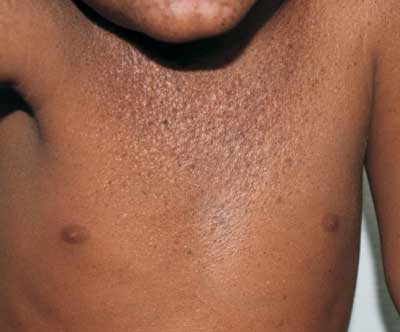|
|
|
Indian Pediatr 2016;53: 85 |
 |
Pigmented Xerodermoid
|
|
*Piyush Kumar, Rizwana Barkat and
#Kamlesh Kumar Agrawal
Department of Dermatology, Katihar Medical College,
Bihar and #Department of Pediatrics,
SMS Medical College, Jaipur, India.
Email: * docpiyush@gmail.com
|
|
A 5-year-old boy, born out of a consanguineous marriage, presented with
pigmented skin lesions involving sun-exposed areas for 2 years (Fig.
1 and Fig.2). The child was born full term at home,
with an uneventful postnatal period; though the milestones of the child
were delayed. The skin lesions had appeared on face two years ago and
gradually involved upper trunk, and exposed parts of extremities. His
younger sister too had similar, but milder skin lesions. His height for
age, weight for age and weight for height were less than 3 standard
deviation. Skin was dry. Multiple hyperpigmented as well as
hypopigmented macules were noted on sun-exposed areas. There was
decreased lacrimation while crying. Ophthalomological examination showed
corneal xerosis. Neurological examination did not reveal any
abnormality. On the basis of clinical findings, diagnosis of pigmented
xerodermoid was made. Strict sun-protection and liberal use of sunscreen
were advised.
 |
|
Fig. 1 Multiple hyperpigmented macules
on face
|
 |
|
Fig. 2 Multiple hyperpigmented macules
with hypopigmented macules. Skin appears atrophic.
|
Xeroderma pigmentosum (XP), is a rare autosomal
recessive disease characterized by sun sensitivity, photophobia, early
onset of freckling, and subsequent neoplastic changes on sun-exposed
skin (median age of onset of non-melanoma skin cancer is 8 years). The
median age of onset of the cutaneous symptoms is 1-2 years and the skin
abnormalities result from genetically acquired inability to repair UV
induced DNA damage. Pigmented xerodermoid, also known as XP variant
(XPV), shows a typical XP phenotype, but is characterized by a
significantly later onset (after 30 years of age), generally milder
symptoms, and a protracted course of the disease. Notably, XPV may
appear earlier in the tropics. Treatment includes strict
photo-protection of the skin and eye, and use of lubricating eye drops.
Regular whole body examination by a dermatologist is needed to identify
and treat premalignant and malignant lesions. Regular ophthalmologic
examination too is desirable. Since strict photo-protection is
advocated, Vitamin D should be given prophylactically.
|
|
|
 |
|

